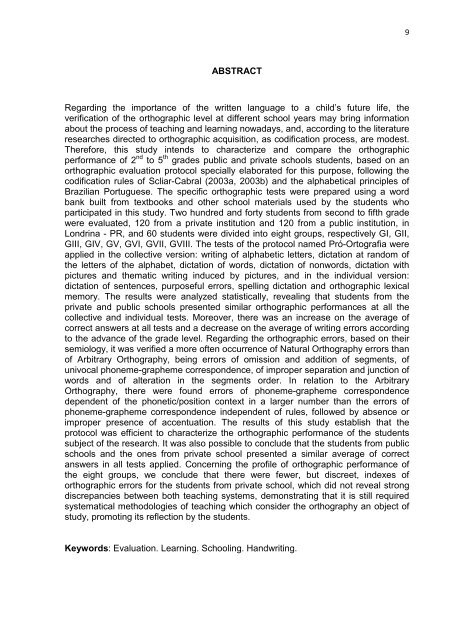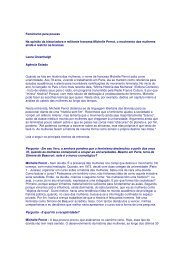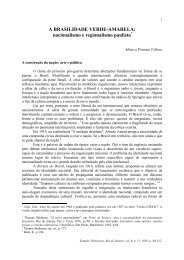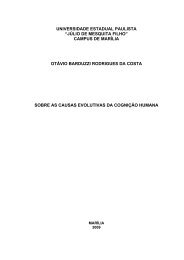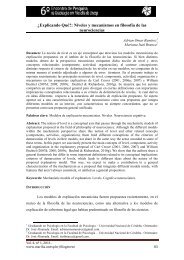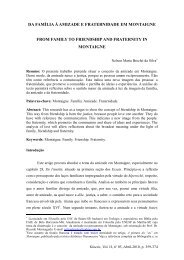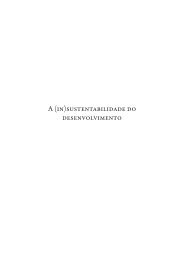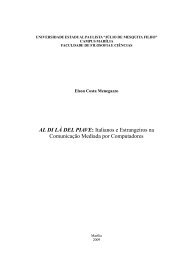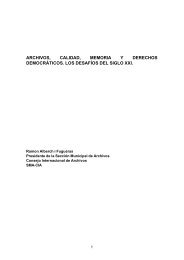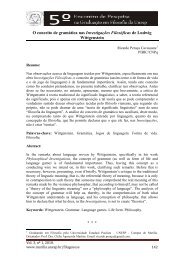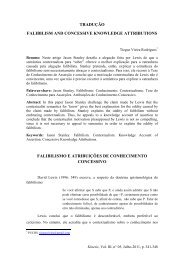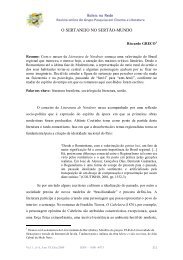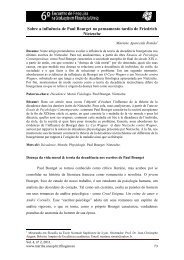Andrea Oliveira Batista DESEMPENHO ORTOGRÁFICO DE ...
Andrea Oliveira Batista DESEMPENHO ORTOGRÁFICO DE ...
Andrea Oliveira Batista DESEMPENHO ORTOGRÁFICO DE ...
Create successful ePaper yourself
Turn your PDF publications into a flip-book with our unique Google optimized e-Paper software.
ABSTRACT<br />
Regarding the importance of the written language to a child’s future life, the<br />
verification of the orthographic level at different school years may bring information<br />
about the process of teaching and learning nowadays, and, according to the literature<br />
researches directed to orthographic acquisition, as codification process, are modest.<br />
Therefore, this study intends to characterize and compare the orthographic<br />
performance of 2 nd to 5 th grades public and private schools students, based on an<br />
orthographic evaluation protocol specially elaborated for this purpose, following the<br />
codification rules of Scliar-Cabral (2003a, 2003b) and the alphabetical principles of<br />
Brazilian Portuguese. The specific orthographic tests were prepared using a word<br />
bank built from textbooks and other school materials used by the students who<br />
participated in this study. Two hundred and forty students from second to fifth grade<br />
were evaluated, 120 from a private institution and 120 from a public institution, in<br />
Londrina - PR, and 60 students were divided into eight groups, respectively GI, GII,<br />
GIII, GIV, GV, GVI, GVII, GVIII. The tests of the protocol named Pró-Ortografia were<br />
applied in the collective version: writing of alphabetic letters, dictation at random of<br />
the letters of the alphabet, dictation of words, dictation of nonwords, dictation with<br />
pictures and thematic writing induced by pictures, and in the individual version:<br />
dictation of sentences, purposeful errors, spelling dictation and orthographic lexical<br />
memory. The results were analyzed statistically, revealing that students from the<br />
private and public schools presented similar orthographic performances at all the<br />
collective and individual tests. Moreover, there was an increase on the average of<br />
correct answers at all tests and a decrease on the average of writing errors according<br />
to the advance of the grade level. Regarding the orthographic errors, based on their<br />
semiology, it was verified a more often occurrence of Natural Orthography errors than<br />
of Arbitrary Orthography, being errors of omission and addition of segments, of<br />
univocal phoneme-grapheme correspondence, of improper separation and junction of<br />
words and of alteration in the segments order. In relation to the Arbitrary<br />
Orthography, there were found errors of phoneme-grapheme correspondence<br />
dependent of the phonetic/position context in a larger number than the errors of<br />
phoneme-grapheme correspondence independent of rules, followed by absence or<br />
improper presence of accentuation. The results of this study establish that the<br />
protocol was efficient to characterize the orthographic performance of the students<br />
subject of the research. It was also possible to conclude that the students from public<br />
schools and the ones from private school presented a similar average of correct<br />
answers in all tests applied. Concerning the profile of orthographic performance of<br />
the eight groups, we conclude that there were fewer, but discreet, indexes of<br />
orthographic errors for the students from private school, which did not reveal strong<br />
discrepancies between both teaching systems, demonstrating that it is still required<br />
systematical methodologies of teaching which consider the orthography an object of<br />
study, promoting its reflection by the students.<br />
Keywords: Evaluation. Learning. Schooling. Handwriting.<br />
9


